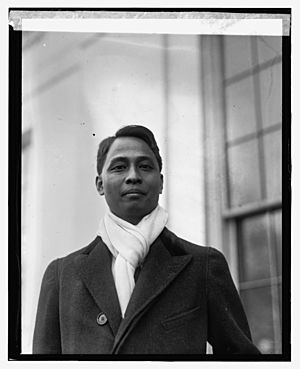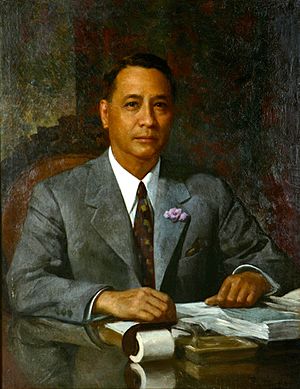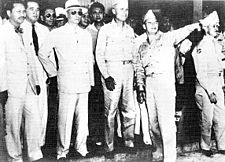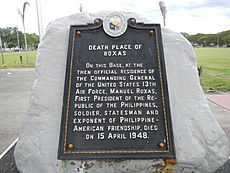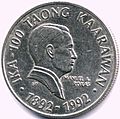Manuel Roxas facts for kids
Quick facts for kids
Manuel Roxas
|
|
|---|---|
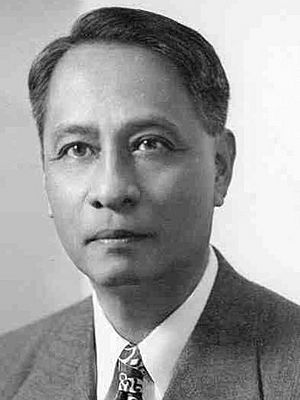 |
|
| 5th President of the Philippines | |
| In office May 28, 1946 – April 15, 1948 |
|
| Vice President | Elpidio Quirino |
| Preceded by | Sergio Osmeña |
| Succeeded by | Elpidio Quirino |
| 2nd President of the Senate of the Philippines | |
| In office July 9, 1945 – May 25, 1946 |
|
| Preceded by | Manuel L. Quezon |
| Succeeded by | José Avelino |
| Senator of the Philippines | |
| In office July 9, 1945 – May 25, 1946 |
|
| 2nd Executive Secretary of the Philippines | |
| In office December 24, 1941 – March 26, 1942 |
|
| President | Manuel L. Quezon |
| Preceded by | Jorge B. Vargas |
| Succeeded by | Arturo Rotor |
| Secretary of Finance | |
| In office August 21, 1941 – December 29, 1941 |
|
| President | Manuel L. Quezon |
| Preceded by | Antonio de las Alas |
| Succeeded by | Serafin Marabut |
| 2nd Speaker of the Philippine House of Representatives | |
| In office October 27, 1922 – May 5, 1934 |
|
| Preceded by | Sergio Osmeña |
| Succeeded by | Quintin Paredes |
| Member of the Philippine House of Representatives from Capiz's 1st district Member of the National Assembly (1935–1938) |
|
| In office 1922–1938 |
|
| Preceded by | Antonio Habana |
| Succeeded by | Ramon Arnaldo |
| Governor of Capiz | |
| In office 1919–1922 |
|
| Preceded by | Jose Hontiveros |
| Succeeded by | Rafael Acuña |
| Member of the Capiz Municipal Council |
|
| In office 1917–1919 |
|
| Personal details | |
| Born |
Manuel Roxas y Acuña
January 1, 1892 Capiz, Capiz, Captaincy General of the Philippines |
| Died | April 15, 1948 (aged 56) Clark Air Base, Angeles, Pampanga, Philippines |
| Cause of death | Heart attack |
| Resting place | Manila North Cemetery, Santa Cruz, Manila, Philippines |
| Political party | Liberal (1946–1948) |
| Other political affiliations |
Nacionalista (before 1946) |
| Spouse |
Trinidad de Leon
(m. 1921) |
| Children |
|
| Alma mater | University of Manila University of the Philippines College of Law (LL.B) |
| Profession | Lawyer, soldier |
| Signature | |
| Nickname | Manoling |
| Military service | |
| Allegiance | |
| Branch/service | Philippine Commonwealth Army |
| Years of service | 1941–1945 |
| Battles/wars | World War II * Japanese Occupation of the Philippines (1942–1945) * Philippines Campaign (1944–1945) |
Manuel Roxas y Acuña (January 1, 1892 – April 15, 1948) was a Filipino lawyer and politician. He served as the fifth president of the Philippines. His term lasted from 1946 until his death in 1948.
He was the third and last president of the Commonwealth of the Philippines. This was from May 28, 1946, to July 4, 1946. After that, he became the first president of the independent Third Philippine Republic. This happened when the United States gave up its control over the Philippines.
Contents
- Early Life and Education
- Manuel Roxas's Political Journey
- The 1946 Presidential Election
- Roxas's Presidency
- Manuel Roxas's Death
- Personal Life
- Manuel Roxas's Legacy
- Images for kids
- Family and Ancestry
- See also
Early Life and Education
Manuel Roxas was born on January 1, 1892. His birthplace was Capiz, which is now called Roxas City. His parents were Gerardo Roxas y Arroyo and Rosario Acuña y Villaruz. His father passed away before he was born. He and his older brother, Mamerto, were raised by their mother and grandfather.
Roxas started his schooling in public schools in Capiz. At age 12, he went to St. Joseph's College in Hong Kong. But he missed home and returned to Capiz. He then went to Manila High School. He graduated with honors in 1909.
He began studying law at a private school. Later, he enrolled at the University of the Philippines. He was elected president of his class and the student council. In 1913, Roxas earned his law degree. He was the top student in his class. He also passed the bar examinations with a high score. After that, he taught law at the Philippine Law School and National University. He also worked as a secretary for Judge Cayetano Arellano of the Supreme Court.
Manuel Roxas's Political Journey
Roxas started his political career in 1917. He became a member of the municipal council in Capiz. He served there until 1919. Then, he became the youngest provincial governor of Capiz. He held this position from 1919 to 1922.
In 1922, Roxas was elected to the Philippine House of Representatives. He served as Speaker of the House for twelve years in a row. He also took part in the Constitutional Convention of 1934. He held important roles like secretary of finance. He also chaired the National Economic Council.
Roxas was a brigadier general in the United States Army Forces in the Far East (USAFFE). He was known as a leader in the guerrilla movement. He was also a military leader in the Philippine Commonwealth Army. Roxas became a key figure in the Nacionalista Party. This party was mostly made up of wealthy landowners called hacendados. These families owned large estates and had a lot of power in the Philippines.
Independence Discussions with the U.S.
During the Great Depression, some in the United States wanted to grant independence to the Philippines. This was partly to stop Filipino immigration and imports. At the same time, Filipino leaders worried about Japan's growing influence in East Asia. They were also concerned about new tariffs on Filipino goods after independence.
In the early 1930s, Roxas went to the United States with Sergio Osmeña. They wanted to slow down the process of independence. They spoke with U.S. government leaders. Roxas said he supported independence. But he also warned about the economic problems that tariffs would cause.
In 1933, Roxas and Osmeña again went to Washington. They discussed independence. The U.S. agreed to grant it. However, they wanted to keep military bases in the Philippines. The Philippine Congress rejected this condition.
Serving in the Senate
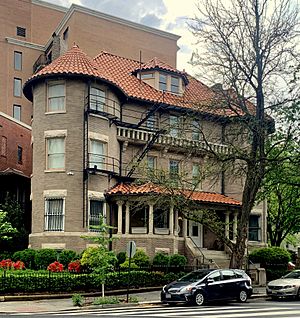
After changes to the 1935 Philippine Constitution in 1941, Roxas was elected to the Philippine Senate. However, he could not serve until 1945. This was because World War II broke out. The United States was supposed to grant independence in 1945. But Japan began to claim control over East Asia.
Before the war, Roxas was an officer in the reserves. He became a link between the Commonwealth government and General Douglas MacArthur's USAFFE headquarters. On December 7, 1941, Japan attacked Pearl Harbor and U.S. bases in the Philippines. Japanese forces then invaded Luzon. Roxas went with President Quezon to Corregidor. He helped destroy Philippine money to keep it from the Japanese.
When Quezon left Corregidor, Roxas went to Mindanao. He helped lead the resistance there. Before Quezon left, Roxas was made executive secretary. He was also named as a possible successor if Quezon or Vice President Sergio Osmeña were captured or killed.
During the Japanese Occupation
In April 1942, Japanese forces captured Roxas. He became a chief advisor to the government led by José P. Laurel. This government worked with the Japanese. Some people claimed Roxas was secretly part of the Filipino resistance. However, there is no clear proof of this.
During the occupation, Roxas managed rice collection for the government. This helped Japan gather rice to feed its forces. These policies caused hardship for many Filipinos. In April 1945, Roxas surrendered to American forces. After his capture, General MacArthur announced that Roxas was actually a resistance fighter.
MacArthur believed that the wealthy landowners, like Roxas, were important for leading the Philippines. He thought they were the only ones who could provide good leadership. MacArthur also strongly preferred Roxas over President Osmeña. He wanted Roxas to be the first president after independence. MacArthur pardoned Roxas and many other Filipinos who had worked with the Japanese.
When the Philippine Congress met again in 1945, Roxas was elected Senate president. Many members of Congress had worked with the Japanese during the war. MacArthur tried to weaken Osmeña's chances in the 1946 Philippine presidential election. He helped Roxas prepare for the election.
The 1946 Presidential Election
| Presidential styles of Manuel Roxas |
|
|---|---|
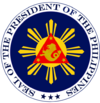 |
|
| Reference style | His Excellency |
| Spoken style | Your Excellency |
| Alternative style | Mr. President |
Before the 1946 elections, Senate President Roxas and his friends left the Nacionalista Party. They formed the Liberal Party. Roxas ran for president, and Elpidio Quirino ran for vice-president. The Nacionalistas nominated Osmeña for president.
General MacArthur strongly supported Roxas. The American military government favored Roxas. They believed he would allow the U.S. to keep its military bases in the Philippines after independence. Roxas also owned a large newspaper company. His newspapers helped his campaign. Osmeña chose not to campaign actively. He believed people knew his reputation. On April 23, 1946, Roxas won the election with 54 percent of the votes. His Liberal Party also won most seats in the legislature.
Roxas's Presidency
Last President of the Commonwealth
On May 28, 1946, before becoming president, Roxas visited the United States. He was with U.S. High Commissioner Paul V. McNutt. During his visit, Roxas clearly supported the U.S. keeping its bases after independence. He said the Philippines would welcome U.S. military bases for mutual protection.
On May 10, 1946, an agreement was drafted in Washington. It allowed the U.S. to keep its bases in the Philippines for 99 years. Roxas wanted fewer American bases. He also wanted American military personnel to follow Filipino laws. The U.S. agreed to reduce the number of bases. They also agreed to mostly have naval and air bases. But they insisted that American military personnel would have immunity from Filipino law.
On May 28, 1946, Roxas became the last president of the Commonwealth of the Philippines. His inauguration was held in the ruins of the Legislative Building. About 200,000 people watched. In his speech, he shared his plans. These included:
- Stronger ties with the United States.
- Joining the United Nations.
- Rebuilding the country after the war.
- Helping ordinary people.
- Fairness for workers.
- Keeping peace and order.
- Protecting citizens' rights and freedoms.
- Ensuring honest and efficient government.
On June 3, 1946, Roxas spoke to Congress. He talked about the serious problems the Philippines faced. He also reported on his trip to the United States to discuss independence.
On June 21, Roxas urged Congress to accept two U.S. laws. These were the Tydings–McDuffie Act (Philippine Rehabilitation Act) and the Bell Trade Act (Philippine Trade Act). Congress accepted both. The Bell Trade Act allowed Filipino goods to enter the American market without tariffs. This was a key goal for Roxas. In return, the Philippine currency was linked to the U.S. dollar. American companies also gained equal rights to use Philippine natural resources. The U.S. Congress also approved about $2 billion in aid for the Philippines. This money was meant for rebuilding the war-damaged nation.
First President of the Third Republic (1946–1948)
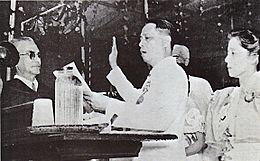
Roxas served as Commonwealth president for a short time. He helped prepare the Philippines for independence. His term as Commonwealth president ended on July 4, 1946. On that day, the Third Republic of the Philippines was officially started. Independence from the United States was declared.
About 300,000 people attended the event. The U.S. flag was lowered, and the Philippine national flag was raised. There was a 21-gun salute and church bells rang. Roxas then took his oath as the first president of the new republic. Chief Justice Manuel Moran administered the oath.
The ceremony took place at Luneta Park in Manila. Many important guests were there. These included President Roxas, Vice President Quirino, and their Cabinet. Also present were the first U.S. Ambassador to the Philippines Paul McNutt and General Douglas MacArthur.
Domestic Policies
Economy
| Population | |
|---|---|
| 1948 |  19.23 million 19.23 million |
| Gross Domestic Product (1985 constant prices) | |
| 1947 | |
| Growth rate, 1947–48 | 39.5% |
| Per capita income (1985 constant prices) | |
| 1947 | |
| Total exports | |
| 1947 | |
| Exchange rates | |
| 1 US$ = Php 2.00 1 Php = US$ 0.50 |
|
| Sources: Philippine Presidency Project Malaya, Jonathan; Malaya, Eduardo. So Help Us God... The Inaugurals of the Presidents of the Philippines. Anvil Publishing, Inc.. |
|
After independence, the Philippines faced huge economic challenges. The country was heavily damaged by the war. Cities like Manila were almost completely destroyed. Over a million people were missing or had died. The Philippines had lost about two-thirds of its wealth.
In 1946, the country's economy was in a very bad state. There was almost no export trade. Imports were very high. The country needed immediate help from the United Nations Relief and Rehabilitation Administration. It also received loans from the United States.
President Roxas took strong actions to improve the economy. He believed in a system of "free but guided enterprise." One key step was creating the Philippine Rehabilitation Finance Corporation. This group helped build houses and gave out loans. Another important step was setting up the Central Bank of the Philippines. This bank helped stabilize the country's money and guide economic growth. Roxas also focused on the sugar industry. He managed to increase sugar production significantly.
Rebuilding After the War
The war left cities and towns in ruins. Farms and factories were destroyed. Roads and bridges were broken. Many industries and businesses were paralyzed. Thousands of civilians were killed. The education system was also badly hit. About 80% of school buildings and equipment were destroyed. Countless books, documents, and artworks were lost. Hundreds of churches were burned. Rebuilding schools alone cost a huge amount of money.
The new republic started with a large annual budget deficit. This meant the government spent much more than it earned. Manila and other cities faced high crime rates. Gangs committed robberies, kidnappings, and burglaries. In rural areas, especially in Central Luzon, groups of bandits caused fear.
Land Reform Efforts
In 1946, President Roxas made the Rice Share Tenancy Act of 1933 active across the country. This law aimed to improve conditions for farmers. However, problems with land ownership continued. In some areas, these problems even got worse.
To help, Republic Act No. 34, also known as the Tenant Act, was passed. This law set a 70–30 sharing arrangement for crops. It also regulated contracts between landowners and tenants. This was done to calm the unrest among farmers in Central Luzon.
Amnesty for Collaborators
On January 28, 1948, President Roxas granted full amnesty to Filipinos who had worked with the Japanese during the war. Many of them were on trial or waiting to be tried. This included former President José P. Laurel. The amnesty did not apply to those who committed common crimes. This decision helped heal divisions among the people. It was seen as a way to unite the nation for its progress.
Civil Unrest
Roxas was against the Hukbóng Bayan Laban sa Hapón (People's Army Against the Japanese), also known as the Huks. He tried to make peace with them. In August 1946, he invited Huk leaders to Manila. But on their way back, one Huk leader, Juan Feleo, and others were attacked by police. Feleo was killed. This attack was meant to weaken the Huks. Instead, it led to a civil war. The police and army lost control of much of Luzon to the Huks.
On March 6, 1948, Roxas declared the Huk movement illegal. At the same time, he pardoned Filipinos who had worked with the Japanese. The Huks argued that Roxas's government was too similar to the wartime government that had collaborated with Japan.
U.S. officials noted that the Philippines was facing challenges with corruption. They believed that the ruling class mostly served its own interests. Some U.S. officials wanted to stop aid to the Philippines due to corruption. However, others feared that cutting aid would strengthen the Huks.
Foreign Policies
Treaty of General Relations
On August 5, 1946, Congress approved the Treaty of General Relations. This treaty was signed by the Republic of the Philippines and the United States on July 4, 1946. In this treaty, the U.S. gave up its control over the Philippines and recognized its independence.
The treaty also allowed the U.S. to keep some military bases in the Philippines for mutual protection. It allowed the U.S. to represent the Philippines in countries where the Philippines did not yet have its own diplomats. The Philippines agreed to take on all debts from the previous government. The treaty also set rules for property rights of citizens from both countries.
United States Military Bases
Roxas successfully got funds from the United States to rebuild the Philippines. However, he had to agree to allow the U.S. to keep military bases. Twenty-three of these bases were leased for 99 years. There were also trade restrictions for Filipino citizens. U.S. property owners and investors received special privileges.
On March 21, 1947, the U.S. gave the Philippines about $17.7 million in military aid. Another $25 million was given for reconstruction. The Huk rebellion caused fears in the U.S. that the Huks might gain power. The U.S. also worried about Communists gaining power in China. This made the Philippines very important to the U.S. The U.S. wanted to keep its air and naval bases in the Philippines. This would help them control the South China Sea. The Americans were willing to pay a lot to keep their bases. Roxas used this to his advantage.
Parity Rights Amendment
On March 11, 1947, Filipino voters approved the "parity amendment" to the 1935 Constitution of the Philippines. This amendment gave United States citizens the right to use and develop Philippine natural resources. These were called parity rights.
Turtle and Mangsee Islands
On September 19, 1946, the Philippines told the United Kingdom it wanted to take over the administration of the Turtle Islands and the Mangsee Islands. This transfer of administration officially happened on October 16, 1947.
Assassination Attempt
The night before the plebiscite, Roxas almost lost his life. A barber named Julio Guillen threw a grenade at the stage where Roxas had just spoken. This happened at Plaza Miranda. Roxas managed to escape harm.
Manuel Roxas's Death
On April 15, 1948, President Roxas gave a speech. This was at the Kelly Theater in Clark Air Base, Pampanga. After his speech, he felt dizzy and tired. He was taken to the home of Major General Eugene L. Eubank. That night, he had several heart attacks. He passed away at 9:23 PM, at the age of 56. Roxas's time as president was the shortest, lasting only 22 months and 18 days.
His body was brought to Manila the next day by special train. It arrived at Malacañang Palace. Congress sessions were stopped until after his burial. The burial was set for Sunday, April 25, 1948. Vice President Elpidio Quirino was on a trip when Roxas died. He arrived in Manila on April 17. That morning, he went to Malacañang and took the oath of office as president. The new president then set up a committee for Roxas's funeral. He also declared a period of national mourning.
Roxas was buried at the Manila North Cemetery.
Personal Life
Manuel Roxas married Trinidad de Leon on April 14, 1921. They had a quiet ceremony in San Miguel, Bulacan. The couple had two children: Ruby and Gerardo (Gerry).
Manuel Roxas's Legacy
On July 3, 1956, Roxas was given the Quezon Service Cross after his death. His wife, Trinidad de Leon-Roxas, received the award. It was presented by then-Vice President Carlos P. Garcia.
Many places in the Philippines have been named after him to honor him. These include:
- Roxas, Oriental Mindoro (1948)
- Roxas, Isabela (1948)
- President Roxas, Capiz (1949)
- Roxas City, Capiz (1951)
- Roxas, Palawan (1951)
- President Roxas, Cotabato (1967)
- President Manuel A. Roxas, Zamboanga del Norte (1967)
Dewey Boulevard in Metro Manila was also renamed in his memory. He is also featured on the 100 Philippine peso bill.
Images for kids
-
Roxas Boulevard in Pasay, named after the president
-
Statue of Manuel Roxas in Roxas City
Family and Ancestry
| Ancestors of Manuel Roxas | |||||||||||||||||||||||||||||||||||||||||||||||||||||||||||||||||||||||||||||||||||||||||||||||||||||||||||||||||||||||||||||||||||||||||||||||||||||||||||||||||||||||||||||||||||||||||||||||||||||||||||||||||||||||||||||||||||||||||||||||||||||||||||||||||||||||||||||||||||||||||
|---|---|---|---|---|---|---|---|---|---|---|---|---|---|---|---|---|---|---|---|---|---|---|---|---|---|---|---|---|---|---|---|---|---|---|---|---|---|---|---|---|---|---|---|---|---|---|---|---|---|---|---|---|---|---|---|---|---|---|---|---|---|---|---|---|---|---|---|---|---|---|---|---|---|---|---|---|---|---|---|---|---|---|---|---|---|---|---|---|---|---|---|---|---|---|---|---|---|---|---|---|---|---|---|---|---|---|---|---|---|---|---|---|---|---|---|---|---|---|---|---|---|---|---|---|---|---|---|---|---|---|---|---|---|---|---|---|---|---|---|---|---|---|---|---|---|---|---|---|---|---|---|---|---|---|---|---|---|---|---|---|---|---|---|---|---|---|---|---|---|---|---|---|---|---|---|---|---|---|---|---|---|---|---|---|---|---|---|---|---|---|---|---|---|---|---|---|---|---|---|---|---|---|---|---|---|---|---|---|---|---|---|---|---|---|---|---|---|---|---|---|---|---|---|---|---|---|---|---|---|---|---|---|---|---|---|---|---|---|---|---|---|---|---|---|---|---|---|---|---|---|---|---|---|---|---|---|---|---|---|---|---|---|---|---|---|---|---|---|---|---|---|---|---|---|---|---|---|---|---|---|---|
|
|||||||||||||||||||||||||||||||||||||||||||||||||||||||||||||||||||||||||||||||||||||||||||||||||||||||||||||||||||||||||||||||||||||||||||||||||||||||||||||||||||||||||||||||||||||||||||||||||||||||||||||||||||||||||||||||||||||||||||||||||||||||||||||||||||||||||||||||||||||||||
See also
 In Spanish: Manuel Roxas para niños
In Spanish: Manuel Roxas para niños


